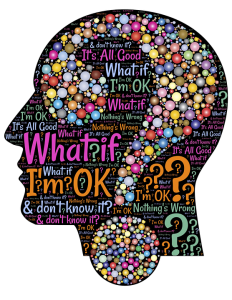Lab-derived combination of GABA & Niacin may help with Anxiety, Mood, Sleep and Focus.
![By Ccroberts (Own work) [Public domain], via Wikimedia Commons](https://supplementsinreview.com/wp-content/uploads/2016/07/Picamilon3d-300x162.png)
- Reducing anxiety. The combination of niacin and GABA may work together to reduce stress hormones, promoting relaxation and reduced anxiety.
- Elevating Mood. Picamilon stimulates the release of dopamine in the brain, rewarding the mind and body with a sense of calm and general well-being.
- Improving Sleep. Higher GABA levels in the brain promote slower brain wave states complementary to sleep, possibly increase sleep quality and duration.
- Alleviating ADHD Symptoms. Both GABA and niacin may have cognitive effects on the brain to improve memory, concentration, focus and attention, and may be useful for easing the symptoms of ADHD.
Overview
Picamilon was created at the All-Union Vitamins Scientific Research Institute in the Soviet Union in 1969 by synthetically merging GABA with Nicotinic Acid (NA).1 GABA is not water-soluble and cannot cross the blood-brain barrier on its own. Niacin is water-soluble and can carry GABA across the blood-brain barrier so it can bind to and activate GABA receptors. Niacin’s vasodilator properties also increase blood flow and oxygen to the brain and heart, lowering blood pressure, heightening concentration and promoting relaxation. Niacin also helps the body metabolize amino acids,2 and works as an important agent in Picamilon to promote the brain’s and body’s absorption of GABA.
![Picamilon marks only one of the many nootropics lurking behind the Iron Curtain. By ru:Лисицкий, Лазарь Маркович(workbio) (Own work) [Public domain], via Wikimedia Commons](https://supplementsinreview.com/wp-content/uploads/2016/07/Mosccow_Poster.jpg)
How Picamilon Might Help the Brain
Enhances Cerebral Blood Flow
The synergistic effects of GABA combined with niacin work to open blood vessels, allowing more oxygen, glucose, and GABA into the blood stream. Considering the overwhelming energy demands of the brain (accounting up to 20% of the body’s total energy supply), enhanced cerebral blood flow can optimize all-around brain function & structure–in addition to promoting more GABA and niacin to reach the brain and remain there over time.
Decreases Stress Hormones
With more GABA and niacin acting on the brain over a longer period of time comes a remarkable decrease in neural stress hormone activity.
One of Picamilon’s GABAergic effects on the brain is the inhibition of the neural release of stress hormones cortisol and adrenaline, effectively deterring the fear response induced by those hormones–instead replacing them with the body’s “pleasure” neurotransmitter: Dopamine.
Increases Dopamine Secretion
Picamilon may induce positive emotional perceptions due to the increased flow of dopamine in the nucleus accumbens. From there Dopamine also flows to the prefrontal cortex, which is partly responsible for processing emotions.
In particular, the nucleus accumbens houses the brain’s pleasure center, which rewards survival-conducive behaviors involved with sex, food, clothing, problem-solving, etc. etc., naturally reinforcing behaviors with an emotionally uplifting feeling in order to encourage repetition of those behaviors.3
The end result is increased Drive & Motivation.
Alleviates ADHD, Anxiety, & Depression Symptoms

Research shows that neurotransmitter deficits in the prefrontal cortex may lead to dysfunction. For one, ADHD has been linked to insufficient dopamine levels in the prefrontal cortex, and even small changes in dopamine levels can lead to marked improvement in ADHD symptoms such as inattention, impulsivity and hyperactivity and heightened emotional response.4
As such, the combined benefits of Picamilon’s enhanced cerebral blood flow, inhibition of stress hormones, and encouragement of dopamine release may alleviate symptoms of ADHD, anxiety and depression and promote focus, attention, relaxation, well-being and better sleep.
Research
Unfortunately, while GABA and niacin are backed by decent clinical studies, Picamilon has yet to pierce the ranks of human trial research. Fortunately, there’s enough positive pre-clinical animal research to warrant further nootropic study and use of Picamilon on human subjects.
But for now, here are a few notable animal studies that seem to represent Picamilon’s benefits:
Animal Research
Inhibition of dopamine receptors are associated with ADHD for the spontaneously hypertensive rat.
In a study researching the effects of dopamine on ADHD, scientists used the spontaneously hypertensive rat (SHR) as an animal model for human ADHD. The premise of this study centered on a theory that behavioral problems associated with ADHD are a secondary reaction to dysfunctional dopamine centers in the limbic and cortical regions of the brain.
- The results of this study suggest that inhibition of dopamine receptors in the nucleus accumbens and prefrontal cortex regions of the brain are a precursor to hyperactivity.5
Picamilon may possess antidepressive, anti-anxiety effects comparable to diazepam (Valium).
This study used rats to determine the effects of Picamilon on emotional state, depression, anxiety and both short-term and long-term memory and cognitive function. The open field test was used to gauge emotional response. The forced swimming test was implemented to test Picamilon’s antidepressant capability. The rats were placed in an elevated maze to measure anxiety levels, while researchers used the crossed-labyrinth test to assess short term memory and passive avoidance versus active avoidance conditioned reflex tests to measure long-term memory and learned behavior.
- This study’s findings showed that preclinical use of Picamilon “combines pronounced vasodilation properties with nootropic effects and tranquilizer activity,” comparable to diazepam (Valium), but without the memory problems. The study’s conclusion also states Picamilon is, “able to restore or increase the physical and psychic capacity to work,” while stressing the need for further research.6
In studies conducted on conscious, unrestrained cats and rabbits, Picamilon increased blood supply to the brain and lowered blood pressure, inhibiting the constriction of carotid blood vessels and reflex activity in the sympathetic nervous system associated with the fear response to external stimuli. This study’s findings suggest, “An essential role in the mechanism of action of Picamilon is its effect on nervous control of the cerebral circulation.” In small doses (1 mg/kg), Picamilon, “prevents the negative consequences of emotional stress” while at higher doses (80-160 mg/kg) it lowered the “brain-stimulation reward threshold,” reducing the number of stimuli needed for a pleasure response.
- The study’s results indicated, “In its effect on cerebral circulation, Picamilon was shown to be more effective than papaverine, nialamide, complamin (xantinol nicotinate), and dihydroergotoxin (redergin),” and “Unlike tranquilizer drugs (chlorodiazepoxide, diazepam, relanium, phenazepam), Picamilon does not induce muscle relaxation, drowsiness or lethargy. Clinicians have stated that the drug closely resembles cavinton (the ethyl ester of apovincamic acid), but comparison of the properties of the two compounds showed that Picamilon is superior.” Researches concluded, “Picamilon is much superior both to GABA and to niacin.”7
Combined, GABA & Niacin seem to strengthen the dopamine pathway for healthier “reward-seeking” behavior.
Dosage Notes
- 50 to 300 mg per day
- 150 mg is a typical serving
- Directions for Use: Take 150 mg in the morning, 150 mg in the evening.
- Cycle: 4 days on, 2 days off. Repeat.
Depending on your Picamilon form (tablet, powder, etc.), you may want to change this to fit your particular schedule–but remember:
Picamilon’s effects generally last for about 4 hours, so space your servings appropriately.
Side Effects
At low doses, Picamilon is reported as Safe.
However, at higher doses those who are sensitive to niacin may experience mild side effects including:
- Flushed skin (i.e. “niacin flush”)
- Dizziness
- Upset Stomach
- Low Blood Pressure
People with kidney or liver problems should talk to a doctor before using Picamilon as possible negative drug interactions include diabetes drugs, blood thinners, antibiotics and thyroid hormones. 8
As a note of caution: Start with a small dosage and build from there.
 Did you know? Until recently, U.S. consumers could purchase Picamilon at GNC distributers, after the Oregon state Attorney General introduced a lawsuit against GNC claiming it knowingly sold supplements containing Picamilon, which is unapproved by the FDA. Although both GABA and niacin are found in nature, Picamilon does not meet FDA requirements for dietary supplements due to its “synthetic” combination of the compounds.9 More on the legality of nootropics.
Did you know? Until recently, U.S. consumers could purchase Picamilon at GNC distributers, after the Oregon state Attorney General introduced a lawsuit against GNC claiming it knowingly sold supplements containing Picamilon, which is unapproved by the FDA. Although both GABA and niacin are found in nature, Picamilon does not meet FDA requirements for dietary supplements due to its “synthetic” combination of the compounds.9 More on the legality of nootropics.Available Forms
In Russia, Picamilon is a prescription drug delivered at a maximum of 200 mg per day. In most other countries, Picamilon is only available online in tablet or powder form. The powder form may be easier for measuring dosages in comparison to tablet form supplements, which contain widely varying amounts of Picamilon.10
Strictly in terms of pricing, powder form typically grants the most bang for your buck on nootropics. Add in the ability to easily monitor your intake and this seems to be the better Picamilon option.
Supplements in Review Recommendation
- Picamilon, 150-300 mg daily, “4 days on, 2 days off” cycle.
Picamilon synergizes two effective nootropics. On their own, GABA and Niacin offer beneficial, brain-healthy effects. Combined, those effects multiply, creating a “1+1=3” synergy on mental performance. Additionally, with the progression of clinical research, Picamilon may prove itself to be a worthy medicinal nootropic anti-depressive anxiolytic.
Prescription, powder, or tablet. The various forms of Picamilon allow for two general uses: Picamilon as a standalone ingredient vs. Picamilon in a stack. Typically we advise against casually stacking standalone ingredients, and the same applies here. To avoid bad ingredient interactions, do your research first before mixing Picamilon with other nootropics.
Leave a Reply